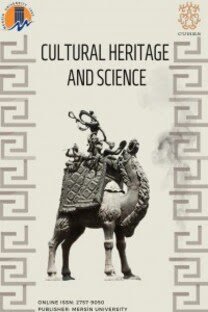Architectural sustainability with cultural heritage values
Architectural sustainability with cultural heritage values
Sustainability and cultural heritage are two interconnected and interdependent issues that are essential for achieving sustainable development. Cultural heritage plays a critical role in society as it is an integral part of the social and cultural fabric. This article focuses on the relationship between sustainability and cultural heritage, specifically the integration of cultural heritage into urban and environmentally sustainable development. To achieve this, the study used Tabriz Bazaar as a case study to explore how cultural heritage can be preserved while balancing economic expansion and sustainable development. The research question is how cultural heritage can be integrated into urban and environmentally sustainable development using Tabriz Bazaar as a case study. The hypothesis is that the preservation and protection of cultural heritage values are crucial for achieving sustainable development, and an interdisciplinary approach is necessary to balance economic expansion with cultural heritage preservation. Using a case study approach, the research collected data through a literature review and interviews with experts in the fields of cultural heritage preservation, urban and environmental sustainability, and economics. The research analyzes the challenges of balancing economic development with cultural heritage preservation and proposes an interdisciplinary approach to address these challenges. To make the area more sustainable and preserve its cultural heritage values, specific measures such as promoting cycling in Tabriz Bazaar were recommended. Moreover, education and awareness-raising programs are also necessary to promote the importance of cultural heritage and its contribution to sustainable development. Overall, the research highlights the interdependence between sustainability and cultural heritage and emphasizes the importance of preserving cultural heritage to achieve sustainable development. Policymakers, urban planners, and cultural heritage conservationists can benefit from the findings of this study to develop strategies that promote sustainable development while preserving cultural heritage values.
___
- Nocca, F. (2017). The role of cultural heritage in sustainable development: Multidimensional indicators as decision-making tool. Sustainability, 9(10), 1882.
- Elyasi, S., & Yamacli, R. (2022). Investigation of Iranian residential buildings with sustainable architecture in hot and dry areas. Journal of Architecture, Engineering & Fine Arts, 4(1), 16-29.
- Çiğan, A., & Yamaçlı, R. (2020). Doğal Enerji, Sürdürülebilir Kalkınma ve Mimarlık Politikaları. Duzce University Journal of Science and Technology, 8, 554_571
- Bonenberg, W. (2019). The Role of Cultural Heritage in Sustainable Development. Values and Valuation as Key Factors in Spatial Planning of Rural Areas. Advances in Human Factors in Architecture, Sustainable Urban Planning and Infrastructure (s. 124-134). Advances in Intelligent Systems and Computing book series.
- Ashfaq, J., Hassan, H., & Khan, A. (2022). The Impact of Mass Media, Word-Of-Mouth on Travel Intention and Mediating Role of Destination Image and Tourist Attitude. International Journal of Academic Research in Business and Social Sciences, 3224-3239.
- Tepebaş, U. (2021). The Contribution of Archaeological Surveys on the Perception of Cultural Heritage: Cilicia as a Case Study. Cultural Heritage and Science, 25-30.
- Sułkowski, Ł. (2020). Covid-19 Pandemic; Recession, Virtual Revolution Leading to De-globalization? Journal of Intercultural Management, 12(1), 1-11.
- Streimikiene, D., Mikalauskiene, A., & Kiausiene, I. (2019). The impact of value created by culture on approaching the sustainable development goals: Case of the Baltic States. Sustainability, 11(22), 6437.
- Rypkema, D. (2005). Cultural heritage and sustainable economic and social development. Europa Nostra.
- Banerjee, T., & Southworth, M. (1990). City Sense and City Design. The MIT Press.
- Seyhan, A. K., & Badem, A. (2018). Erzincan ilindeki hayvansal atıkların biyogaz potansiyelinin araştırılması. Academic Platform-Journal of Engineering and Science, 6(1), 25-35.
- Naycı, N., Abruzzese, D., Güler, C., Tağa, H., Cammarano, P., Vuth, S., & Türkoğlu, H. (2020). Multidisciplinary Researches in Cultural Heritage Studies: An Approach on Akkale Cistern in Erdemli, Mersin. Cultural Heritage and Science, 1(1), 15-22.
- Karataş, L. (2022). Conservation status of intangible cultural heritage after restoration: Case study of Mardin Spice Bazaar. Cultural Heritage and Science, 3(2), 30-36.
- Yayın Aralığı: Yılda 2 Sayı
- Başlangıç: 2020
- Yayıncı: Mersin Üniversitesi
Sayıdaki Diğer Makaleler
Research on the change of Ankara Ulus City Center identified with its historical texture
Architectural sustainability with cultural heritage values
Systematic analysis of the digital technologies used in the documentation of historical buildings
Fatma Zehra ÇAKICI, Rabia KAÇDİ
Edirne New Palace excavations (2018-2021)
Yavuz GÜNER, Gülay APA KURTİŞOĞLU
Exploring structural deterioration at historical buildings with UAV photogrammetry
